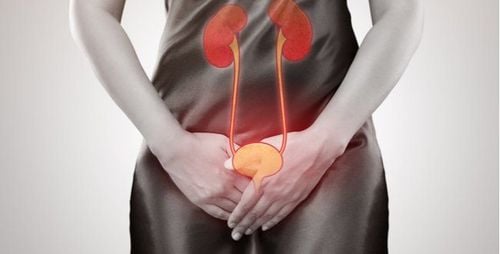This is an automatically translated article.
Urinary tract infections are common, especially in women. Urinary tract infections, if not treated promptly, can gradually affect kidney function causing many dangerous complications even death.
1. What is a urinary tract infection?
Urinary tract infection is a condition in which bacteria enter the urinary tract system including the kidneys, ureters, bladder and urethra. Bacteria enter the urinary tract mainly through the upstream route from the urethra, so women have a higher risk of urinary tract infections than men due to the structure of the female urethra, so bacteria can easily penetrate. What are the types of urinary tract infections? Depending on the location of the infection, it can be divided into 2 types: Upper urinary tract infections: Infections from the kidney to the ureter opening in the bladder wall, but mainly kidney damage such as acute pyelonephritis. Lower urinary tract bacteria: From the bladder to the urethral opening, including cystitis, urethritis.

Vi khuẩn xâm nhập dẫn đến nhiễm trùng đường tiết niệu
2. Complications of urinary tract infections
Untreated urinary tract infections, urinary tract infections can cause complications such as:
Pyelonephritis causing permanent kidney damage Sepsis is often caused by pyelonephritis, making it easy for bacteria to enter and blood causes sepsis Pregnant women with urinary tract infections are at risk of miscarriage or preterm delivery Urethral stricture due to recurrent urethritis
3. Cause
Caused by bacteria entering the urinary tract through the urethra, back to the bladder, ureters, and kidneys. Bacteria that cause urinary tract infections include:
Escherichia coli (E. coli) is the main cause of urinary tract infections Other bacteria cause urinary tract infections such as: Staphylococus, Klebsiella, Proteus, ..

Vi khuẩn E.coli là nguyên nhân chính gây nhiễm khuẩn tiết niệu
4. Risk factors
Women because of the structure of the genitals, bacteria are easier to penetrate into the urethra than men. All women are at risk for UTIs because of the short distance between the urethra and the anus and the urethral opening to the bladder. Having sex increases the risk of UTIs more than someone who is not sexually active. Poor genital hygiene. Women use spermicides to prevent pregnancy. Postmenopausal women are at increased risk of urinary tract infections. After menopause, the decline in estrogen leads to changes in the urinary tract that make it more susceptible to infections. Congenital malformations of the urinary tract that prevent urine from draining as usual or urine backflow, so there is a risk of UTIs. Obstruction in the urinary tract. Kidney stones or an enlarged prostate can lead to urine retention in the bladder and increase the risk of UTIs. Diabetes and diseases that weaken the immune system such as HIV-AIDS increase the risk of UTIs. Insert urinary catheter. People who are unable to urinate on their own and use a tube (catheter) to urinate are at risk of UTIs. People with urinary incontinence such as paralysis have an increased risk of urinary tract infections People with urinary tract interventions such as surgery, urethral dilation, ...

Mãn kinh làm tăng nguy cơ nhiễm khuẩn tiết niệu ở phụ nữ
5. Symptoms of a urinary tract infection
Urinary tract infection may have signs and symptoms such as:
Painful urination, painful urination, painful urination Cloudy urine Low back pain, lower stomach pain High fever, shivering Urinating disorders such as hematuria in inflammation bladder, or difficult urination, painful urination, ...
6. Diagnosis of urinary tract infections
Tests to diagnose urinary tract infection include:
Routine urinalysis by instructing the patient to collect urine midstream. The test looks for white blood cells, red blood cells, proteins, etc. Urinary tract bacteria culture from urine. This test tells the doctor which bacteria is causing the urinary tract infection, and the bacteria are analyzed for an antibiotic to find out which antibiotic is most effective. Image analysation. Ultrasound, computed tomography (CT) or magnetic resonance imaging (MRI) help find the causes of urinary tract malformations causing urinary tract infections Cystoscopy . Your doctor may perform a cystoscopy to see inside the urethra and bladder to help diagnose disease.

Chẩn đoán nhiễm khuẩn tiết niệu bằng hình ảnh
7. Prevention
Drink a lot of water. Drinking plenty of water helps to urinate frequently, which helps to flush out bacteria. Clean the genitals or after using the toilet, before and after sex, should wipe from front to back to help prevent bacteria in the anal area from spreading to the vagina and urethra. Urinate immediately after intercourse. Avoid products that are likely to cause genital irritation. Vinmec International General Hospital is one of the hospitals that not only ensures professional quality with a team of leading doctors, modern equipment and technology, but also stands out for its examination and consulting services. and comprehensive, professional medical treatment; civilized, polite, safe and sterile medical examination and treatment space. Customers when choosing to perform tests here can be completely assured of the accuracy of test results.
Customers can directly go to Vinmec Health system nationwide to visit or contact the hotline here for support.













